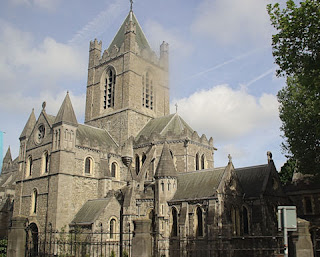Our tour of Ireland started in the Republic of Ireland, where the Great Famine and ruins were the main themes. There were a few other sites of interest, too, which I will cover at the end of the post.
We came across our first references
to the Great Famine our very first day in Ireland, when we saw a famine
memorial and visited a famine ship. The memorial is composed of several
sculptures showing starving people making their way to the seaports to find a
better life elsewhere. The famine ship is a replica of the Jennie Johnston, which
was called a famine ship because it took starving emigrants across the ocean to
North America—primarily Canada. These ships were also called “coffin ships”
because many of the passengers didn’t make it, although the Jennie Johnston
was an exception. One of her voyages even arrived with one more passenger than
it left with.
The next two photos show the famine
memorial and the replica of the Jennie Johnston.
During the tour, we learned more
about the famine. The potato crop was the only one affected, and wealthier people
and most city-dwellers had enough to eat, but tenant farmers relied on potatoes
as their principal crop and food, so when the blight arrived in Ireland in 1845
and decimated the crop over the next few years, those families starved. And
since many of them couldn’t pay their landlords, evictions were common. The
government did try to provide some relief, with the idea of taking it to the
people, but one of the men administering the relief wasn’t willing to give up
his physical comforts to travel to the back country. When he made them come to
him, the famine march became a death march. We drove by part of the route, but
the memorial itself was down roads the bus couldn’t travel.
The last year of the famine was 1852.
When it was over, approximately one million people had died and another one
million had emigrated to other countries, dropping Ireland’s population by
about 20%.
We also saw a lot of ruins during our
tour. The first was the Glendalough Ecclesiastical Settlement, which is the ruins
of an old monetary. It was established by St. Kevin in the 6th century.
Round towers were a prominent feature of monasteries a thousand years ago,
functioning as a bell tower to call people to worship or inform them of
important events, and the one at Glendalough is well preserved. Also well-preserved
is St. Kevin’s Church, which is also known as St. Kevin’s Kitchen because the chimney
looks a lot like one you find in a kitchen . Legend has it that when the
Normans plundered the monastery in the 12th century, they didn’t
bother with St. Kevin’s Church because they thought it was where food was
prepared rather than a religious building. The next two photos show the round
tower and St. Kevin’s Church (behind the graveyard).
We also visited the Rock of Cashel,
which is better preserved than Glendalough. It started as a fortress but was
turned over to the church body in 1101 when the King of Munster wanted to curry
favor with the church (and probably with God, as well). The next photo shows
the Rock of Cashel from down below.
The other well-known ruin we saw was
Blarney Castle. That’s it in the photo at the head of this post. As a fiction
writer I’m already filled with blarney, and Roland had heard stories about the
locals using the stone as a toilet, so neither of us was interested in taking
the long climb up a narrow stairway to kiss the stone. The castle grounds have
a decent garden, but other than that we both considered it a waste of time. I
couldn’t even get a photo of the stone from below.
Although we saw a number of other
ruins from a distance, the only one worth mentioning is a ring fort that we
viewed from above. The American Embassy in Dublin was designed to resemble these
ancient forts. The next to photos show the old and the new.
Famine exhibits and ruins weren’t all
the highlights of the Republic of Ireland, however. The following photos show
St. Patrick’s Cathedral (Dublin), Kilkenny Castle (Kilkenny), Cong (where the
exteriors were filmed for The Quiet Man with John Wayne and Maureen O’Hara),
Kylemore Abbey (where nuns still live and work), the Cliffs of Moher, and a sheepdog
demonstration (near Sligo).
One other stop is worth mentioning.
At Waterford, we got a tour of the Waterford factory, which we both enjoyed.
The final photos show glass blowing (cutting the stem for a wine glass), a girl
cutting a design into a wine glass, and a crystal violin that sells for just
under $25,000.
Next week I’ll blog about our visit to Northern Ireland.


























No comments:
Post a Comment